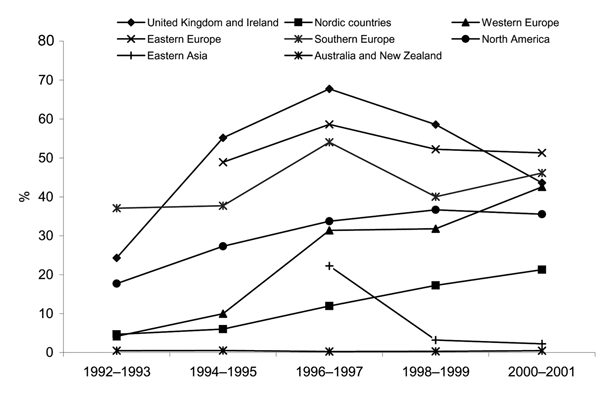Volume 11, Number 6—June 2005
Research
International Salmonella Typhimurium DT104 Infections, 1992–2001
Figure 2

Figure 2. . Salmonella enterica serovar Typhimurium DT104 as percentage of all S. Typhimurium in 8 world regions, 1992–2001. Only countries that had data available for 2 or more 2-year periods are included: United Kingdom and Ireland: England and Wales, Scotland, Ireland; Scandinavia: Denmark, Finland, Norway, Sweden; Western Europe: Austria, Germany, and the Netherlands; Eastern Europe: Czech Republic and Hungary; Southern Europe: Spain and Israel; North America: Canada, United States; Eastern Asia: the Republic of Korea; Oceania: Australia and New Zealand.
1Data for this survey were contributed by the DT104 study group, which consisted of the following: Diane Lightfoot and J. Powling, Australia; Christian Berghold and Christian Kornshober, Austria; Ingrid Wybo, J.M. Collard, and C. Godard, Belgium; Dalia dos Prazeres Rodrigues, Eliane Moura Falavina dos Reis, and Erica L. Fonseca, Brazil; Kathryn Doré, James Flint, Frank Pollari, Rafiq Ahmed, and Walter Demczuk, Canada; James Hospedales, Denise Clarke, and Michelle Nurse-Lucas, Caribbean Region; Renata Karpiskova, The Czech Republic; Peter Gerner-Smidt, Denmark; Noël Gill, Sarah O'Brien, and John Threlfall, England and Wales; Anja Siitonen and Susanna Lukinmaa, Finland; Wolfgang Rabsch, Germany; Panayotis T. Tassios, Leonidas S. Tzouvelekis, and Takis Panagiotopoulos, Greece; Judit Pàszti and Noelni Nógrády, Hungary; Barbara Foley, Martin Cormican, and Paul McKeown, Ireland; Nahum Andorn and Ruti Yishai, Israel; Haruo Watanabe and Hidemasa Izumiya, Japan; Bok Kwon Lee and Shukho Kim, Republic of Korea; J. Selga and J. Jansone, Latvia; Joel Mossong and François Schneider, Luxembourg; Julie Haider and Paul Cuschieri, Malta; Wilfrid van Pelt, Netherlands; Helen Heffernan and Carolyn Nicol, New Zealand; Karin Nygård and Trine Lise Stavnes, Norway; B.L. Cherkasskiy, Russian Federation; Lynda Browning and John Coia, Scotland; Karen Helena Keddy and Tersia Kruger, Republic of South Africa; Miquel Anger Usera, Spain; Agneta Olsson, Sweden; Patrick Boerlin, Switzerland; Timothy Barrett, Frederick J. Angulo, and Jennifer E. Stevenson, USA.